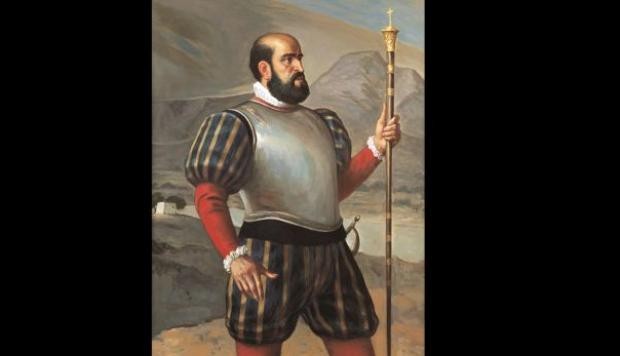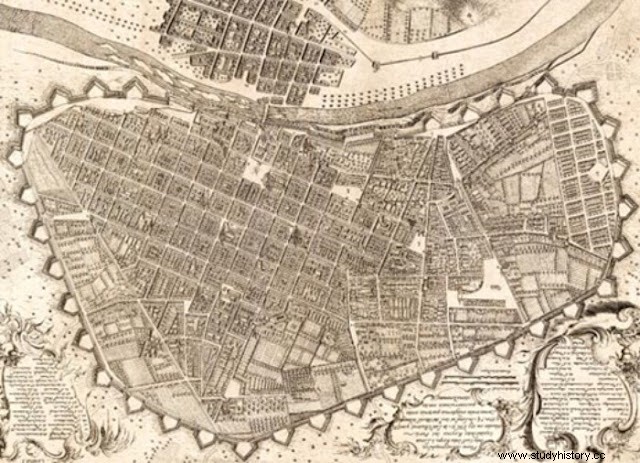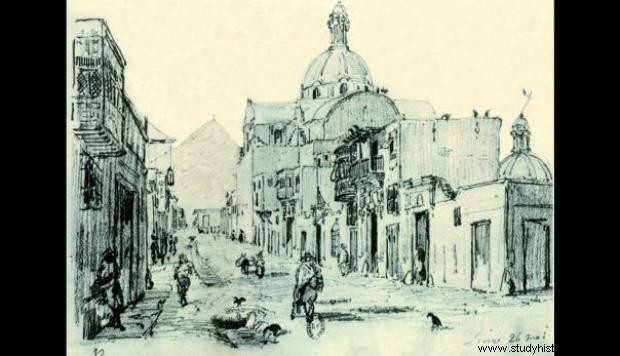The adventurous life of Nicolás de Ribera. He came with Francisco Pizarro and was one of the famous thirteen of the Isla del Gallo. In its almost three centuries of Hispanic rule, Lima or the City of Kings had two hundred and eighty-seven mayors, who governed for a year with a substitute, at resemblance of the council of Seville. Of that long list, the only one that survives in the memory of some Limeños is Nicolás de Ribera, nicknamed El Viejo, first mayor in 1535, the year of the Spanish foundation. He repeated the management four more times:1544, 1546, 1549 and 1554.
 Nicolás de Ribera "The Old Man"
Nicolás de Ribera "The Old Man" A CHECKERBOARD His story does not end there. We know that together with Diego de Agüero, and under the topographical indications of Juan Tello, Ribera was one of the "tracers" of the new city. It was because of them that Los Reyes was designed in the form of a grid or checkerboard, like the Roman camps. It must have been complicated to adapt the 117 blocks that were projected due to the pre-existence of pre-Hispanic shrines, paths and canals. They decided to bring the square near the river, not to the center of the checkerboard, and only 62 blocks were square. Likewise, it seems that Ribera was decisive in choosing the first name of the city, since he wrote in a document that José A. del Busto cites:"It was called the city of the kings because it was the day of the kings when they went out to it." The original nomenclature, then, was due to the decision to erect it on January 6, the Three Kings holiday. Ribera's next contribution to the city is more complex, since he was his authority or his neighbor for almost thirty years, until his death in 1563. He had to face threats from the hosts of Manco Inca as well as lawsuits between Pizarristas and Almagristas. He received the first viceroy, Blasco Núñez de Vela, but did not accept his authority and opposed the abolition of the encomiendas, since he had received a distribution of Indians in Pisco.

RURAL ASPECT The Lima of don Nicolás must have had a sullen appearance, with the pillory located in the Plaza de Armas with the decapitated heads of the rebel leaders. A still rural city, with tree-lined paths that gave access to the checkerboard, with orchards and flowery gardens, noisy ditches and low houses, made of adobe, over which the vaults of the temples appeared, like the primitive cathedral, with its simple bell towers.
THE FIRST NEIGHBOR Our character was born in 1492 in the town of Olvera (Cádiz). When he went to the Indies he settled in Panama. There he met Pizarro and Almagro, and soon became involved in the discovery of Peru. He was on the first trip as treasurer of the king and on the second he was part of the thirteen from the island of Gallo who refused to abandon Pizarro.

Due to the fame of his loyalty to the “Peruvian host”, he he added that of conciliator, especially in the disputes between Pizarro and Almagro. He was not in the capture of Atahualpa, but he arrived with Almagro in Cajamarca in 1533. As governor of Jauja he went down to the coast and founded a town of Spaniards in Pachacámac and another in Sangallán, near Pisco, called "Lima la Vieja". He witnessed the founding ceremony of the City of Kings, that hot morning of January 18, and his first burgomaster was chosen. The lot that corresponded to him was located next to the Santo Domingo square. The façade of his mansion faced Veracruz street, today the second block of the Conde de Superunda street, in front of the convent of the Dominican friars. Then his descendants lived there, the counts of Santa Ana de las Torres, who commissioned the stone doorway to be carved and the box-shaped balconies to be carved, which still exist, although much renovated. Upon his death, he was buried in the first Cathedral, in a chapel acquired by him and his wife, Elvira Dávalos y Solier. When the new cathedral was built, his remains were transferred to the Chapel of Santa Ana, in the nave of the Epistle. Before he died, he founded the Ica Hospital for Natives on May 13, 1556.
SOURCE:EL COMERCIO
